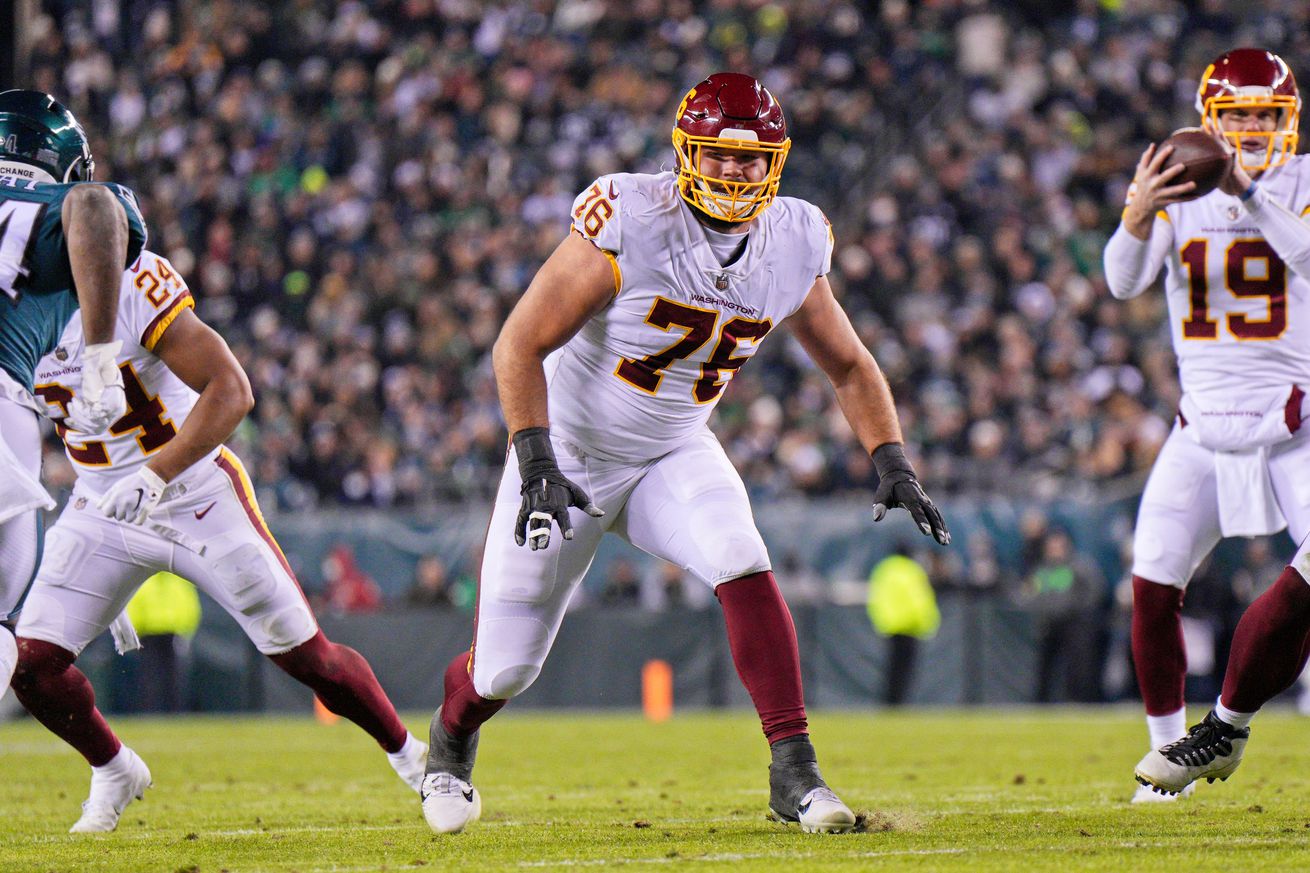
Investigating hit rates for drafting NFL-ready offensive tackles
This offseason has seen perhaps the most radical overhaul of a roster ever undertaken in Washington. It had to happen, because the roster left behind by the previous regime was largely devoid of the premium talents required to compete for championships.
GM Adam Peters was recruited in January from the San Fransisco 49ers, where he had been an integral part of John Lynch’s personnel team, which led a three-year rebuild of that franchise following the disastrous Chip Kelly experiment. Within four months of being hired, Peters had replaced the entire senior coaching staff and turned over around 12 starting positions on the roster, based on Bill in Bangkok’s most recent depth chart, including quarterback.
Peters’ approach to the draft was certainly different to that of the guy he replaced, who had left behind the smoking wreck of a roster that he was now tasked with rebuilding. As I reported in my What We Learned about Adam Peters series after the draft, the Commanders took a disciplined approach to drafting the best players available from their vertical board. This approach is in keeping with the draft philosophy espoused by GMs of the best drafting teams, including the Ravens and Lions, in addition to the 49ers.
One thing, in particular, which seems to have put a few noses out of joint is that he did not deviate from his board to address perceived needs at offensive tackle.
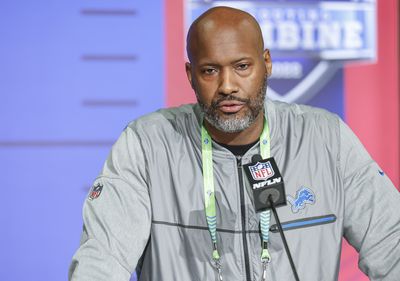
Photo by Michael Hickey/Getty Images
Detroit Lions’ EVP/GM Brad Holmes articulated why good teams stick to their boards, rather than reaching to address needs, in response to pretty much the same question that people are raising about Peters’ choices. Having traded with Dallas to pick CB Terrion Arnold in the first round, the Lions doubled up on the position by selecting CB Ennis Rakestraw Jr. 61st overall, near the end of the second round, rather than an edge rusher or an offensive tackle, which were viewed as major needs for his team. This is what Holmes had to say:
I hate to sound like a broken record, but again, thrilled with how it fell tonight. Obviously, Ennis was a guy we had ranked very, very high. He’s another one that we didn’t think was going to make it that far. We didn’t even know if he was going to make it out of, really, the first night…
You can win the headlines in March and April and all that stuff. That’s easy to draft whatever the premium positions are — quarterback and edge rusher and tackle and those positions. Say you draft only those positions, but they’re not contributing to your football team. So, did you win the draft? Did you win the draft because you drafted those positions? But they’re not contributing to your football team.
Or do you draft the best football players that contribute to your football team that make you a better football team? We’re trying to draft football players that contribute and make us a better football team versus just those.
Had the previous regime in Washington adhered to that philosophy, we might not be having this discussion now. In the 2021 draft, when the Commanders were on the clock at the 19th overall pick, OT Christian Darrisaw was the top player on most media experts’ draft boards. Instead of selecting Darrisaw, Rivera opted for LB Jamin Davis, who played a position that many considered to be a more pressing need at the time. Many still did even a year later. Three seasons later, Darrisaw is one of the best left tackles in the game, and the Commanders are without a long term solution at the position.
Two very different arguments have been put forward about why Adam Peters was mistaken for not drafting offensive tackles earlier and more often than he did in his first draft for the Commanders.
LASkin has argued that Adam Peters erred by not taking more offensive tackles. The gist of his argument is that Peters failed to adequately restock the talent pipeline to make up for years of neglect of the position by Ron Rivera and even his predecessors. LASkin is well aware of the developmental timelines of offensive tackles:
It takes years to develop most OTs and other OL. Most college OL need one to three years of physical, mental, and skill development to be ready to play in the NFL. Every team needs a pipeline. It is usually uncertain whether an OT taken after the first couple of rounds will make it at all, or how long it will take for that player to mature. And no one can predict when injuries to starters will create a need for the OT to play. Therefore, any team needs to draft players now who will be able to start in future years, not necessarily in 2024.
In fact, the steep learning curve that most offensive tackles face coming into the NFL is central to his argument about why it was imperative to start the rebuilding process right away, to ward off disaster in future seasons. LA’s beef with Adam Peters’ draft choices really comes down to a disagreement over using early round draft picks on developmental prospects, rather than prioritizing players who are expected to have a more immediate impact. He also had some quibbles with his choices made on Day 3. Those are topics for another day.
Another more alarmist criticism is also making the rounds. It has been suggested that Adam Peters has neglected his responsibility to safeguard rookie QB Jayden Daniels by failing to make sufficient effort to upgrade the OT position in both free agency and the draft.
As far as failing to do enough in free agency is concerned, any claims are just idle speculation if we don’t know which free agent OTs were or were not contacted by the Commanders and whether any deal terms were discussed.
The argument that the Commanders’ new GM failed to do enough in the draft to solidify the OT position for 2024 appears to be based on a misunderstanding of the realities of drafting and developing offensive tackles.
The sense of urgency which seems to have developed around this issue in some sectors might also have to do with a lack of appreciation of how Washington’s existing offensive tackles compare to the rest of the NFL. Misconceptions on this point are understandable, given the poor availability of metrics to accurately measure pass blocking performance.
In order to shed light on these topics, I undertook an analysis of offensive tackles drafted from 2019 through 2023 to determine the likelihood of drafting players who are better pass protectors than Andrew Wylie and Cornelius Lucas straight out of the gate.
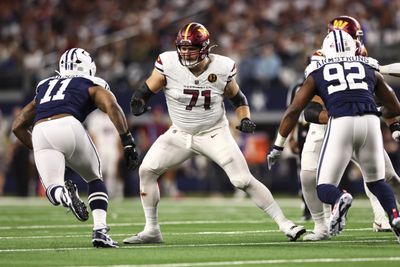
Photo by Kevin Sabitus/Getty Images
Being Better than Wylie and Lucas
In order to upgrade the pass protection for Jayden Daniels in 2024, Adam Peters would have needed to draft at least one offensive tackle who was better than the players on the current roster in his rookie season. Ideally, he should have drafted two. In order for the draftee to upgrade the OT position in 2024, he would need to satisfy the following requirements:
- Earn significant starting time as a rookie
- Be better at pass protection as a rookie than Andrew Wylie and/or Cornelius are now
Let’s put some flesh on those criteria.
Rookie Season Playing Time
A first-year draft pick wouldn’t be much help to Jayden Daniels if he spends most of his rookie season on the bench. He would have to earn significant playing time to keep the veteran alternatives off the field. I initially set a fairly lenient criterion of 8 or more games started as a rookie for this analysis. However, when I looked at the data, I discovered that the players who were good at pass protection as rookies had naturally sorted themselves out into a large group who earned 9 or more starts as rookies and 3 others who started 5 or 4 games. I will therefore state the criterion for a first-year starting OT as having started 9 or more games. But you could also set it at 6 or more starts, without affecting the results.
Better at Pass Protection than Andrew Wylie and Cornelius Lucas
Measuring blocking performance is a vexed issue. PFF blocking grades are based on an “analyst’s” subjective grading of a player’s contribution to team success on each play in a season. The analysts doing the grading have to guess at the player’s assignment. Pass Block Win Rate is based on an arbitrary criterion of holding a block for 2.5 seconds, regardless of what else took place on the field.
Rather than relying on those metrics I chose a more objective measure, which gets at what we are hoping for the blocker in question to achieve: keeping his quarterback clean. The metric I settled on was Pressure Rate allowed (Press. %), calculated as the total of QB pressures attributed to a blocker in a season, expressed as a percentage of total snaps in pass protection. Data were sourced from Pro Football Focus Premium Stats.
Pressures include, sacks, QB hits and QB hurries. There is still an element of subjectivity involved in grading pressures and attributing them to a blocker. However, the grading is based on clearly defined criteria and is less subjective than PFF player grades. While researching this article, I discovered that there is poor agreement between PFF Pass Blocking Grades and Pressures Allowed in pass protection, which makes me wonder what Blocking Grades are actually even measuring.
Andrew Wylie. Last season, Wylie played a total of 693 pass block snaps at RT and allowed a Pressure Rate of 6.06%. He had the 41st lowest pressure rate amongst 83 offensive tackles who played a minimum of 200 pass block snaps. He was pretty much the middle of the pack.
Cornelius Lucas. Lucas started four games and played a total of 152 pass block snaps, predominantly at LT. He allowed a Pressure Rate of 5.26%. That figure would have slotted in between the 26th and 27th ranked OTs who played over 200 pass block snaps. He was a little better than average in fairly limited action.
Why Not Sack Rate?
Since the aim of this exercise is to keep the QB upright, it might seem that the best measure is Sack Rate. There are two reasons that Sack Rate is not as good a measure of pass blocking as Pressure Rate.
The lesser of the two reasons is that sacks are fairly rare occurrences in a football game. Measuring player performance based on rare events like sacks, fumbles and interceptions can lead to erroneous conclusions due to effects of small samples.
The main reason is that sacks depend on both the blocker and the QB he is blocking for. There is a huge amount of variation between QBs in the ability to avoid converting pressures into sacks. That ability is quantified by Pressure to Sack Rate, which is simply the percentage of total pressures that were sacks. In 2023, the most sack-prone starting QB, Ryan Tannehill, had a Pressure to Sack Rate of 30.2% (out of 34 QBs, min 250 dropbacks). Tannehill was more than three times more likely to succumb to pressure than Josh Allen, who led the league with a Pressure to Sack Rate of just 10%.
In 2023, Andrew Wylie spent most of the season blocking for the fourth most sack-prone QB in the NFL. Sam Howell had a Pressure to Sack Rate of 23.5%. Wylie finished the season with an attributed Sack Rate of 1.30% of blocking snaps. The previous season, he blocked for the best QB in the league at avoiding pressure. Blocking for Patrick Mahomes (Pressure to Sack Rate 10.1%), Wylie’s Sack Rate was only 1.04%, a reduction of 20% compared to 2023.
To separate the contributions of the blocker and the QB he is blocking for, as much as possible, I settled on Pressure Rate as the criterion, rather than Sack Rate.
Drafted Rookie OTs Who Were Better than Wylie and Lucas
The following table shows all the OTs drafted from 2019 through 2023 who played 20% of the maximum number of OT blocking snaps in their rookie seasons. Over the period in question, the average minimum was 265 blocking snaps per season.
According to NFL.com, which lists drafted players by the position groups they worked out with at the Combine, a total of 98 OTs were drafted in the last five years. The table lists the 50 players who met the minimum playing criterion at the OT position in their rookie seasons. Almost half of the draftees failed to get enough playing time or switched positions in the NFL. Players who were drafted as OTs, but played guard or center as rookies were excluded.
Pressure Rates below 6.06% (Wylie) but higher 5.26% (Lucas) are indicated in RED. Pressure Rates below 5.26% are indicated in BLUE.
OTs who would have been an upgrade over Andrew Wylie this season (Pressure Rate < 6.06%, 9 or more games started) are shaded in MAUVE. OTs who would have been an upgrade over both of Washington’s presumptive starters this season (Pressure Rate < 5.26%, 9 or more games started) are shaded in BLUE.
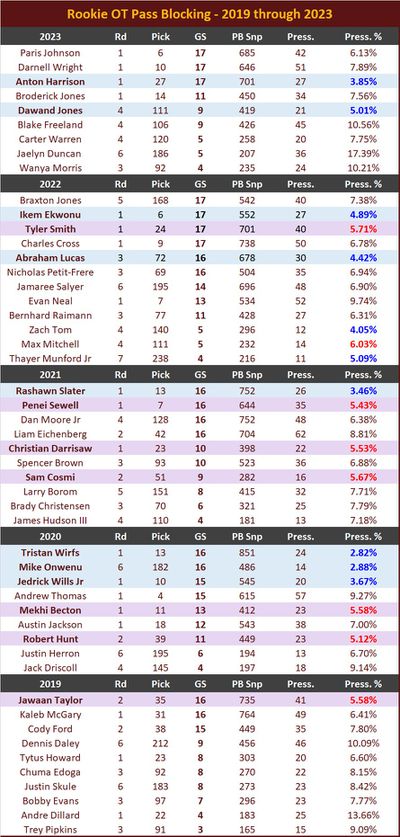
A total of 15 OTs drafted in the last five years were better than Andrew Wylie as rookies, representing 15.3% of the total OT draft pool. However, they were not all evenly distributed throughout the draft. Nine of the 15 (60%) who were better than Andrew Wylie were drafted in the first round. Believe it or not, after the first round, first year starting OTs who are better in pass protection than Andrew Wylie become few and far between.
One of the few rookie OTs who was better than Wylie was Washington’s very own Sam Cosmi.
Three other OTs drafted in 2022 were also better in pass protection than Wylie as records. The maximum playing time recorded by any of them was 296 pass block snaps in five starts. That is not likely to be enough to make a major difference for Washington’s rookie QB. One of the three, Max Mitchell, was only three hundredths of a percent better than Wylie.
Only eight OTs drafted from 2019 through 2023 would have been upgrades over Cornelius Lucas in their rookie seasons, representing just 8.2% of the drafted players. It turns out that Cornelius Lucas sets an extremely high bar for a rookie OT in pass protection. Some might argue that Zach Tom and Thayer Munford Jr. should also be included in that group, since they allowed lower Pressure Rates than Lucas, despite only starting five and four games, respectively. Adding them to the total brings the overall hit rate up to 10.2%.
Of the eight drafted OTs who were better than Cornelius as rookies, five (62.5%) were drafted in the first round.
It is worth pointing out that several OTs who have developed into very good, and even elite, pass protectors were not as good as Washington’s presumptive starters as rookies. Such players include Kaleb McGary, Austin Jackson, and Andrew Thomas. If the aim is to draft depth players to develop for the future, then the talent pool is larger than these criteria make it appear. However, if the aim had been to draft a first year player to upgrade the position for the coming season, a team picking after the first round would be facing an uphill climb in any draft year.
To get a more granular view of the challenge that Peters would have faced, let’s have a look at the past hit rates for drafting rookie OTs better than Wylie and Lucas by draft round.
Hit Rates for Drafting OT Upgrades by Round
Hit rates were calculated as the percentage of OTs drafted in each round who met criteria as being better than Wylie and better than Wylie and Lucas in pass protection as rookies.
Total numbers of OTs drafted per round were taken from the NFL.com draft tracker. Offensive tackles frequently move to interior offensive line when they enter the NFL. The draft tracker draws from Combine workout data and is therefore the best available representation of positions that players were drafted to play. The playing time and Pressure Rate data are drawn from Pro Football Focus, which does play-by-play breakdowns of pre-snap positions, to ensure that I was not counting players who switched to guard or center in the NFL.
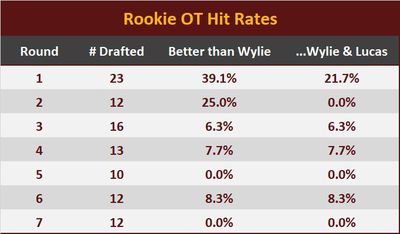
Over the past five drafts, teams picking in the first round have hit on players who would represent an upgrade over Andrew Wylie as rookies just over 39% of the time. Finding an upgrade over Cornelius Lucas to start Year 1 is even more challenging. Teams picking in the first round achieved a hit rate approaching 22%.
Most of the good first-year starters get picked in the first round. Teams picking in the second round had a 25% hit rate for finding upgrades over Andrew Wylie. None of the 12 OTs picked from 2019 through 2023 would have been an upgrade over Lucas in their rookie seasons.
After the second round, the hit rates drop below 10% in every round. No offensive tackles who were better pass protectors as rookies than Andrew Wyle were drafted in the fifth or seventh rounds in the past five years.
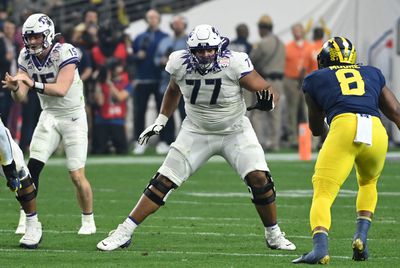
Photo by Norm Hall/Getty Images
Conclusion
Despite all of the negative publicity and hype, the Commanders’ presumptive starting OTs for 2024 were actually middle-of-the-pack at keeping defenders away from their QB in 2023, when compared to other OTs who earned significant playing time around the league. The perception that Andrew Wylie and Cornelius Lucas are dangerous liabilities in pass protection might be influenced by the fact that the quarterback they spent most of the season blocking for was the fourth worst at avoiding pressure in the NFL.
Neither Wylie nor Lucas is likely to be voted to the All Pro team in 2024. The Commanders will need to upgrade the OT position on their way to becoming a championship contender. But any sense of impending doom based on their pass protection performance in 2023 would seem to be unwarranted.
The suggestion that Adam Peters failed in his responsibility to draft players to shore up the Commanders’ pass protection in Jayden Daniel’s rookie season is on equally shaky ground. That argument appears to be based on a misconception about the timeline for development of offensive tackles in the NFL and overestimation of the chances of drafting a player who can outperform a competent, if unspectacular NFL veteran in his rookie season.
After the first round, the chance of drafting a first year starter to successfully address a immediate need at offensive tackle is insufficient to justify deviating from the team’s draft board. As Brad Holmes said, in the introduction, making the need pick at a premium position is a good way to earn high instant draft grades. But it might not look as good a few years later, if doing so involved leaving better players on the board for other teams.
